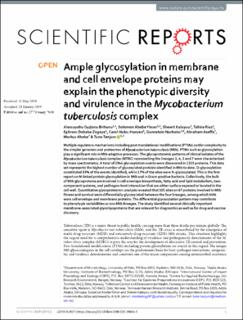| dc.contributor.author | Birhanu, Alemayehu Godana | |
| dc.contributor.author | Yimer, Solomon Abebe | |
| dc.contributor.author | Kalayou, Shewit | |
| dc.contributor.author | Riaz, Tahira | |
| dc.contributor.author | Zegeye, Ephrem Debebe | |
| dc.contributor.author | Holm-Hansen, carol | |
| dc.contributor.author | Norheim, Gunnstein | |
| dc.contributor.author | Aseffa, Abraham | |
| dc.contributor.author | Abebe, Markos | |
| dc.contributor.author | Tone, T | |
| dc.date.accessioned | 2022-07-25T13:54:01Z | |
| dc.date.available | 2022-07-25T13:54:01Z | |
| dc.date.created | 2019-09-17T18:25:48Z | |
| dc.date.issued | 2019 | |
| dc.identifier.issn | 2045-2322 | |
| dc.identifier.uri | https://hdl.handle.net/11250/3008374 | |
| dc.description.abstract | Multiple regulatory mechanisms including post-translational modifications (PTMs) confer complexity to the simpler genomes and proteomes of Mycobacterium tuberculosis (Mtb). PTMs such as glycosylation play a significant role in Mtb adaptive processes. The glycoproteomic patterns of clinical isolates of the Mycobacterium tuberculosis complex (MTBC) representing the lineages 3, 4, 5 and 7 were characterized by mass spectrometry. A total of 2944 glycosylation events were discovered in 1325 proteins. This data set represents the highest number of glycosylated proteins identified in Mtb to date. O-glycosylation constituted 83% of the events identified, while 17% of the sites were N-glycosylated. This is the first report on N-linked protein glycosylation in Mtb and in Gram-positive bacteria. Collectively, the bulk of Mtb glycoproteins are involved in cell envelope biosynthesis, fatty acid and lipid metabolism, two-component systems, and pathogen-host interaction that are either surface exposed or located in the cell wall. Quantitative glycoproteomic analysis revealed that 101 sites on 67 proteins involved in Mtb fitness and survival were differentially glycosylated between the four lineages, among which 64% were cell envelope and membrane proteins. The differential glycosylation pattern may contribute to phenotypic variabilities across Mtb lineages. The study identified several clinically important membrane-associated glycolipoproteins that are relevant for diagnostics as well as for drug and vaccine discovery. | |
| dc.language.iso | eng | |
| dc.title | Ample glycosylation in membrane and cell envelope proteins may explain the phenotypic diversity and virulence in the Mycobacterium tuberculosis complex | |
| dc.type | Peer reviewed | |
| dc.type | Journal article | |
| dc.description.version | publishedVersion | |
| dc.source.journal | Scientific Reports | |
| dc.identifier.doi | 10.1038/s41598-019-39654-9 | |
| dc.identifier.cristin | 1725882 | |
| cristin.unitcode | 7502,4,9,0 | |
| cristin.unitname | Avdeling for molekylærbiologi | |
| cristin.ispublished | true | |
| cristin.fulltext | original | |
| cristin.qualitycode | 1 | |
